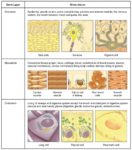Human Bone Structure
The human bone structure, also known as the skeletal system, serves as a framework for the body, providing support, protection, and enabling motion. It consists of many individual bones and cartilages, along with bands of fibrous connective tissue, the ligaments, and tendons.
Composition of Bones
Bones consist mostly of the protein collagen, which forms a soft framework. The mineral calcium phosphate hardens this framework, giving it strength. The bones contain 99% of the bodys calcium. Bone tissue differs greatly from other tissues in the body. Bone is hard and many of its functions depend on that characteristic hardness.
ubdivisions of the Skeleton
The human skeleton consists of two principal subdivisions, each with origins distinct from the others and each presenting certain individual features:
1. Axial Skeleton: Comprising the vertebral column (the spine) and much of the skull.
2. Appendicular Skeleton: To which the pelvic (hip) and pectoral (shoulder) girdles and the bones and cartilages of the limbs belong.
Gross Anatomy of Bones
A long bone has two main regions: the diaphysis and the epiphysis. The diaphysis is the hollow, tubular shaft that runs between the proximal and distal ends of the bone. The outer walls of the diaphysis are composed of dense and hard compact bone. The wider section at each end of the bone is called the epiphysis, which is filled internally with spongy bone. Each epiphysis meets the diaphysis at the metaphysis.
Bone Cells and Matrix
Ground substance and collagen fibers create a matrix that contains osteocytes. These cells are the most common cell found in mature bone and responsible for maintaining bone growth and density.
Bone Nourishment and Innervation
On the outside of bones, there is a layer of cells that grow, repair, and remodel bone as well. These cells are part of the outer double-layered structure called the periosteum. The periosteum also contains blood vessels, nerves, and lymphatic vessels that nourish compact bone. Tendons and ligaments attach to bones at the periosteum.
Functions of the Skeleton
The functions of the skeleton are of three different types: support, protection, and motion. The vertebral column, corresponding to the notochord in lower organisms, is the main support of the trunk. The central nervous system lies largely within the axial skeleton, the brain being well protected by the cranium and the spinal cord by the vertebral column.
In conclusion, the human bone structure is a complex and dynamic system that plays a crucial role in various bodily functions. Its intricate design and composition allow it to perform its functions effectively, making it an essential component of human anatomy..



